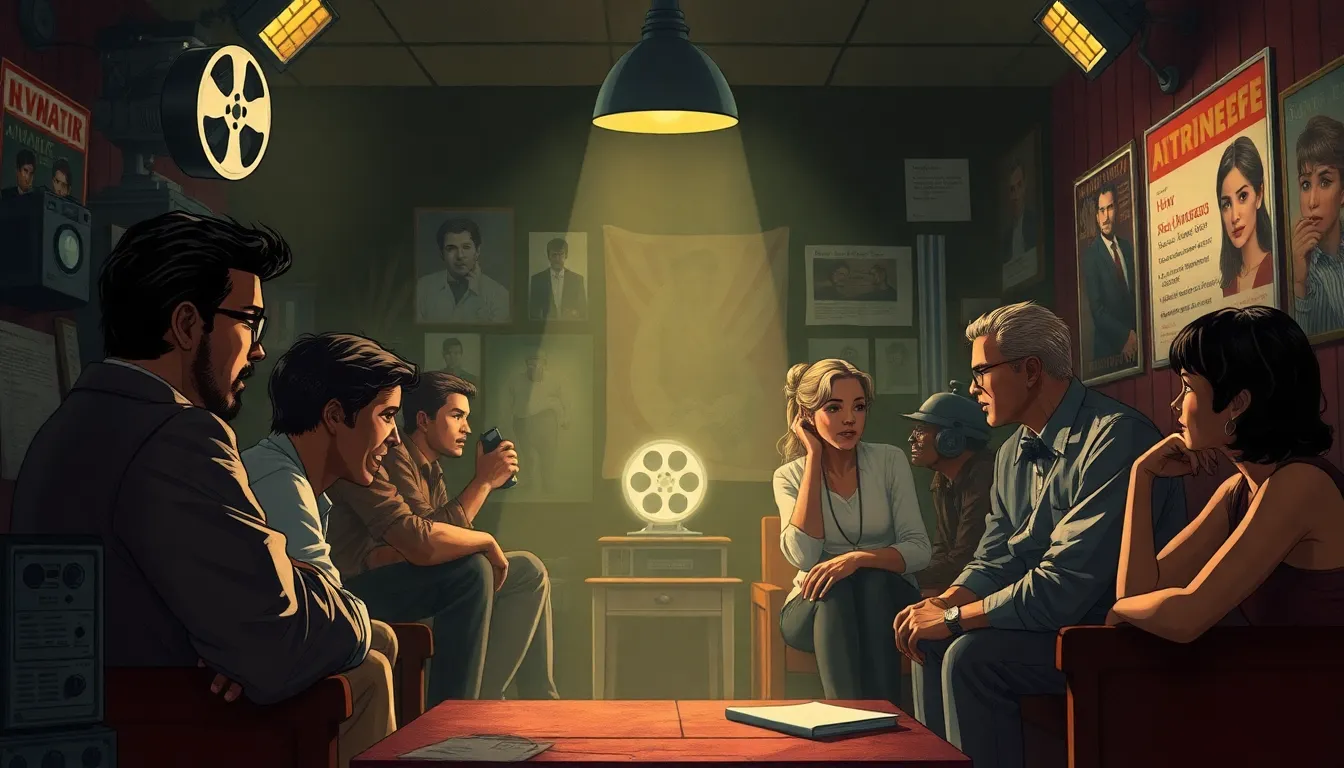Table of Contents
ToggleLights, camera, action! Who doesn’t love a good movie? Whether it’s the heart-pounding thrill of a blockbuster or the tear-jerking moments of a drama, films have a magical way of whisking us away from reality. But let’s face it, not every cinematic adventure is worth the popcorn. That’s where an in-depth movie review swoops in like a caped hero, ready to save your weekend plans.
In-Depth Movie Review: Overview
In-depth movie reviews provide essential insights about films, guiding viewers in their selection process. Reviews assess various elements, including direction, acting, cinematography, and screenplay. Each component influences the overall impact of a movie, enabling audiences to appreciate its strengths and weaknesses.
Critics often analyze plot structures, character development, and thematic relevance. Engaging discussions appear in reviews, where critics evaluate specific performances that stand out. A talented cast can elevate a film, while poor acting may detract from its success.
Cinematography plays a crucial role, shaping the viewing experience through visual storytelling. Effective use of lighting, camera angles, and shot composition enhances emotional resonance. Sound design, another critical factor, contributes to the overall atmosphere and immersion.
Genres dictate different critical approaches. For instance, action films require a focus on pacing and stunts, whereas dramas emphasize character arcs and thematic depth. Each genre offers diverse viewing experiences, highlighting the need for tailored evaluation methods.
Specific examples often illustrate points made in reviews. A movie’s critical reception can shift perceptions, especially if it receives accolades or awards. Box office success may also influence public interest, prompting viewers to explore films hailed by critics.
Guidance from comprehensive reviews allows audiences to make informed decisions. It’s essential to consider the target demographic and marketing strategies when assessing a film’s appeal. Understanding these factors enables viewers to enjoy films that align with their preferences.
Plot Analysis

Analyzing a film’s plot reveals its core messages and artistic choices. A well-crafted narrative engages viewers, drawing them into the story while often reflecting deeper themes.
Major Themes
Common themes in movies often explore love, loss, redemption, and the struggle between good and evil. In many stories, these themes resonate with audiences, establishing emotional connections. Characters frequently face moral dilemmas that challenge their beliefs, prompting viewers to reflect on their own values. In a suspenseful thriller, themes of trust and betrayal intensify the stakes, while a romantic drama might highlight the complexities of relationships. Strong thematic elements contribute to a film’s lasting impact on audiences.
Character Development
Character arcs play a pivotal role in a film’s success. Main characters typically undergo significant transformation, impacting their motivations and choices. Growth often emerges from challenges or conflicts that force characters to confront their fears. Secondary characters also contribute to main characters’ journeys, providing support or opposition along the way. A well-developed character can evoke empathy, making their struggles feel relatable. Viewers frequently invest emotionally in characters who evolve throughout the narrative, enhancing the overall viewing experience.
Cinematic Techniques
Cinematic techniques play a crucial role in shaping the viewer’s experience. They encompass various elements, including direction, cinematography, and audio design.
Direction and Cinematography
Direction influences a film’s storytelling and control over artistic elements. Each choice, from camera angles to shot composition, significantly affects audience engagement. Cinematographers work closely with directors to establish the visual language. Lighting enhances mood and emphasizes key moments, creating lasting impressions. Fluid camera movements can evoke emotions, directing focus on pivotal scenes. In action films, fast-paced cuts maintain tension, while slow scenes in dramas allow introspection. Both styles illustrate the importance of cinematography as it guides viewers through the narrative.
Soundtrack and Score
Soundtracks enrich emotional depth and influence audience perception. Background music complements visuals, intensifying emotions during critical scenes. A well-composed score enhances atmosphere, linking moments to viewers’ reactions. The use of silence can evoke suspense or highlight character introspection. Iconic soundtracks often leave lasting impressions, becoming synonymous with their films. Integrating diegetic sounds adds realism, immersing viewers in the story. Effective sound design ensures that every auditory component enhances the film’s overall impact.
Audience Reception
Audience reception often reflects the overall impact a film has on its viewers. Box office numbers provide initial insights, highlighting how popular a film becomes upon release. Critics’ scores, such as those from Rotten Tomatoes or Metacritic, serve as benchmarks for gauging critical acclaim versus public opinion.
Reviews frequently encompass a range of emotions, from enthusiasm to disappointment. Audience comments on social media platforms or review sites reveal personal interpretations and feelings about the film. Additionally, word-of-mouth recommendations significantly influence how films perform long-term.
Demographic responses vary widely. For instance, younger audiences might connect more with action-oriented films, while older viewers may prefer character-driven dramas. Viewer feedback often emphasizes particular elements, such as plot twists or emotional depth, which resonate with them.
Innovative marketing campaigns can also shape audience anticipation and reception. Take, for example, viral trailers or interactive promotions that engage potential viewers and spark conversation. Effective marketing increases visibility and generates buzz, impacting box office performance.
Numerous films benefit from festival screenings, where early audience reactions can forecast future success. Crowds at festivals tend to provide candid feedback that filmmakers consider for final cuts or promotional strategies. As a result, initial responses at these events often create a ripple effect upon a wider release.
Critical acclaim can tilt audience perception positively. Awards and nominations may enhance a film’s reputation, drawing more viewers who seek acclaimed content. Consequently, even films that initially underperform may see a resurgence based on this increased recognition.
Overall, examining audience reception provides a comprehensive view of a film’s cultural impact and lasting legacy. It highlights how various factors—demographics, marketing, and critical feedback—interact and shape public perception.
Box Office Performance
Box office performance serves as a key indicator of a film’s commercial success. Initial weekend earnings often dictate a film’s longevity in theaters. For instance, films that gross over $100 million during their opening weekends typically generate buzz and encourage viewership.
Historical data reveals trends showing a correlation between strong marketing strategies and box office results. Franchises like the Marvel Cinematic Universe attract loyal fanbases, leading to significant ticket sales. In contrast, independent films often rely on word-of-mouth to boost their numbers, sometimes achieving success through festival circuits.
Audience demographics significantly impact box office outcomes. Certain films appeal more to younger audiences, while others resonate with older viewers. Films that engage diverse groups result in increased profitability, especially when tailored marketing campaigns highlight these attributes.
Critics’ scores also influence box office performance. High ratings on platforms like Rotten Tomatoes or Metacritic often encourage more viewers to check out the film. In some cases, an Oscar nomination can lead to a significant surge in ticket sales.
Examining release timing reveals strategic choices filmmakers make for maximizing returns. Holiday weekends frequently yield higher ticket sales due to increased audience availability. Conversely, films released during competitive seasons may struggle.
Annual box office records showcase the impact of blockbuster films. For example, films like “Avatar” and “Avengers: Endgame” shattered previous records, setting new benchmarks in the industry. Such performances highlight not only the films’ quality but also effective revenue strategies.
Statistics gathered illustrate varying levels of success among different genres. Action and adventure films generally lead in revenue, while dramas may perform modestly despite critical acclaim. Understanding these dynamics helps industry stakeholders make informed decisions about future projects and marketing tactics.
Conclusion
The world of cinema is rich and diverse offering experiences that resonate deeply with audiences. In-depth movie reviews serve as invaluable tools for viewers navigating this vast landscape. By dissecting various elements of film such as direction and character development critics illuminate what makes a movie truly engaging.
These reviews not only enhance the viewing experience but also foster a deeper understanding of the narratives and themes at play. As audiences seek films that align with their preferences informed choices become essential. Ultimately the art of film criticism enriches the cinematic journey allowing viewers to appreciate the craft behind their favorite stories.




